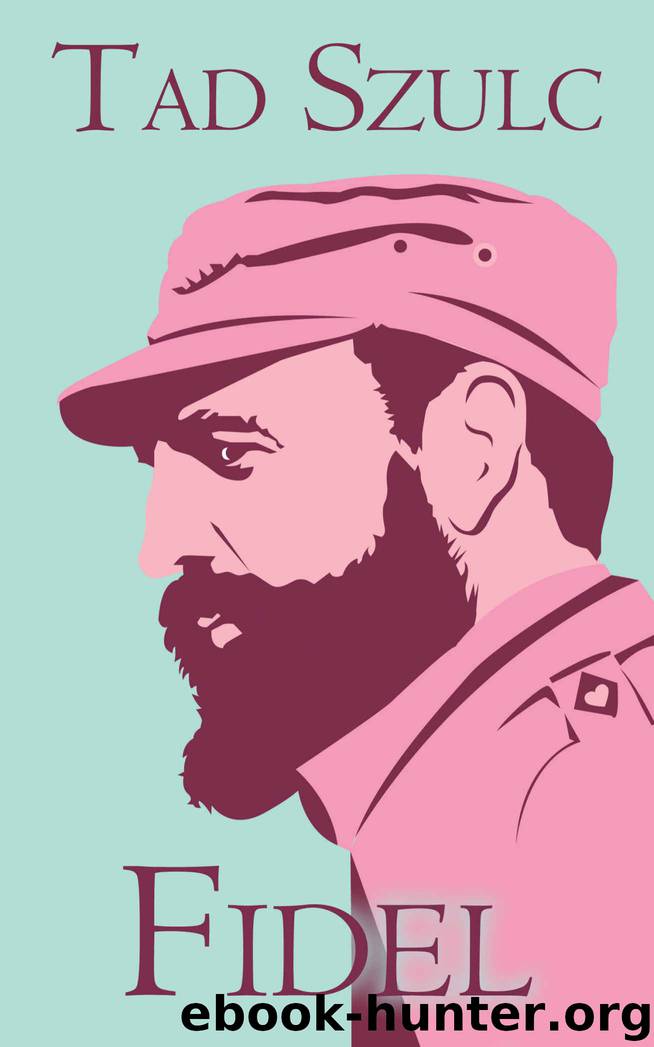Fidel: A Critical Portrait by Tad Szulc

Author:Tad Szulc [Szulc, Tad]
Language: eng
Format: mobi, epub
Tags: Biography, Non Fiction
Published: 2015-07-12T18:30:00+00:00
CHAPTER
9
The crossing of the Granma from Tuxpán on the Mexican coast of the Gulf to the coast of Oriente province in Cuba was pure nightmare, lasting seven days and four hours instead of the five days and nights that Fidel Castro had planned. Terrifying weather whipped up by a powerful El Norte wind, mechanical breakdowns, the yacht's staggering burden of eighty-two heavily armed men in lieu of the twenty-five passengers she was built to transport (Castro had left an additional fifty rebels behind simply because there was not even a square inch of space to spare aboard), and the presence of only three professional sailors contributed to the misery and the delay. The delay, in turn, provoked an unnecessary tragedy ashore.
Castro's plan was risky because of the number of men aboard the Granma, but it was not unreasonable. In relatively good weather, it should have worked to the extent that they would arrive at the landing point roughly on time, and the chosen route—adding up to 1,235 miles—made strategic sense. The yacht was to sail a virtually straight west-east track: from Tuxpán to the exit from the Gulf of Mexico at the tip of the Yucatán peninsula; then crossing the passage between the peninsula's tip and the westernmost point of Cuba (potentially the most dangerous area because Cuban Navy and Air Force patrols could spot the Granma the most easily there); dipping south at a safe distance from Cuba's southern coasts; and hitting the western shores of Oriente province below Niquero. The risk of being caught in the Gulf of Mexico was minimal because operationally it was too far for Batista's air and sea forces, and once the vessel had entered the Caribbean, Castro capitalized on the deception factor of sailing east far from the Cuban coast until Oriente coast was sighted, then making a run for it. Batista's ships and planes were not patroling that far south; Castro was practically in British waters off the Cayman Islands.
The extremely foul weather rendered the crossing exceedingly difficult, with the Granma riding the waves, much too heavy, mechanically unfit, and poorly steered. Castro could not delay the departure because he feared the Mexican authorities would pounce on the expedition at any moment, liquidating the whole enterprise. His decision was to sail immediately, betting that luck would stay with him. He dispatched a telegram from Mexico City to Frank País in Santiago on November 27 reading: ORDERED BOOK IS OUT-OF-PRINT, signed by Divulgación publishers, which was the code for announcing the departure and the anticipated landing early on November 30. Two other coded wires went to Havana for the Students' Revolutionary Directorate and to Santa Clara for the local underground.
Bad weather, however, worked against Batista, too. The regime began to believe privately that Castro was mad enough to make the dash to Cuba, and its intelligence services came up with a list of vessels in Mexican ports that the rebels might be planning to use in an invasion; the list included the name of Granma.
Download
This site does not store any files on its server. We only index and link to content provided by other sites. Please contact the content providers to delete copyright contents if any and email us, we'll remove relevant links or contents immediately.
| Military | Political |
| Presidents & Heads of State | Religious |
| Rich & Famous | Royalty |
| Social Activists |
Waking Up in Heaven: A True Story of Brokenness, Heaven, and Life Again by McVea Crystal & Tresniowski Alex(36998)
Empire of the Sikhs by Patwant Singh(22163)
We're Going to Need More Wine by Gabrielle Union(18064)
Hans Sturm: A Soldier's Odyssey on the Eastern Front by Gordon Williamson(16557)
Leonardo da Vinci by Walter Isaacson(11894)
The Radium Girls by Kate Moore(10901)
Educated by Tara Westover(7055)
Tools of Titans by Timothy Ferriss(6934)
How to Be a Bawse: A Guide to Conquering Life by Lilly Singh(6686)
The Last Black Unicorn by Tiffany Haddish(5065)
Permanent Record by Edward Snowden(4986)
The Rise and Fall of Senator Joe McCarthy by James Cross Giblin(4839)
Promise Me, Dad by Joe Biden(4439)
The Wind in My Hair by Masih Alinejad(4420)
The Crown by Robert Lacey(4098)
A Higher Loyalty: Truth, Lies, and Leadership by James Comey(4024)
The Iron Duke by The Iron Duke(3635)
Joan of Arc by Mary Gordon(3253)
How to be Champion: My Autobiography by Sarah Millican(3180)
